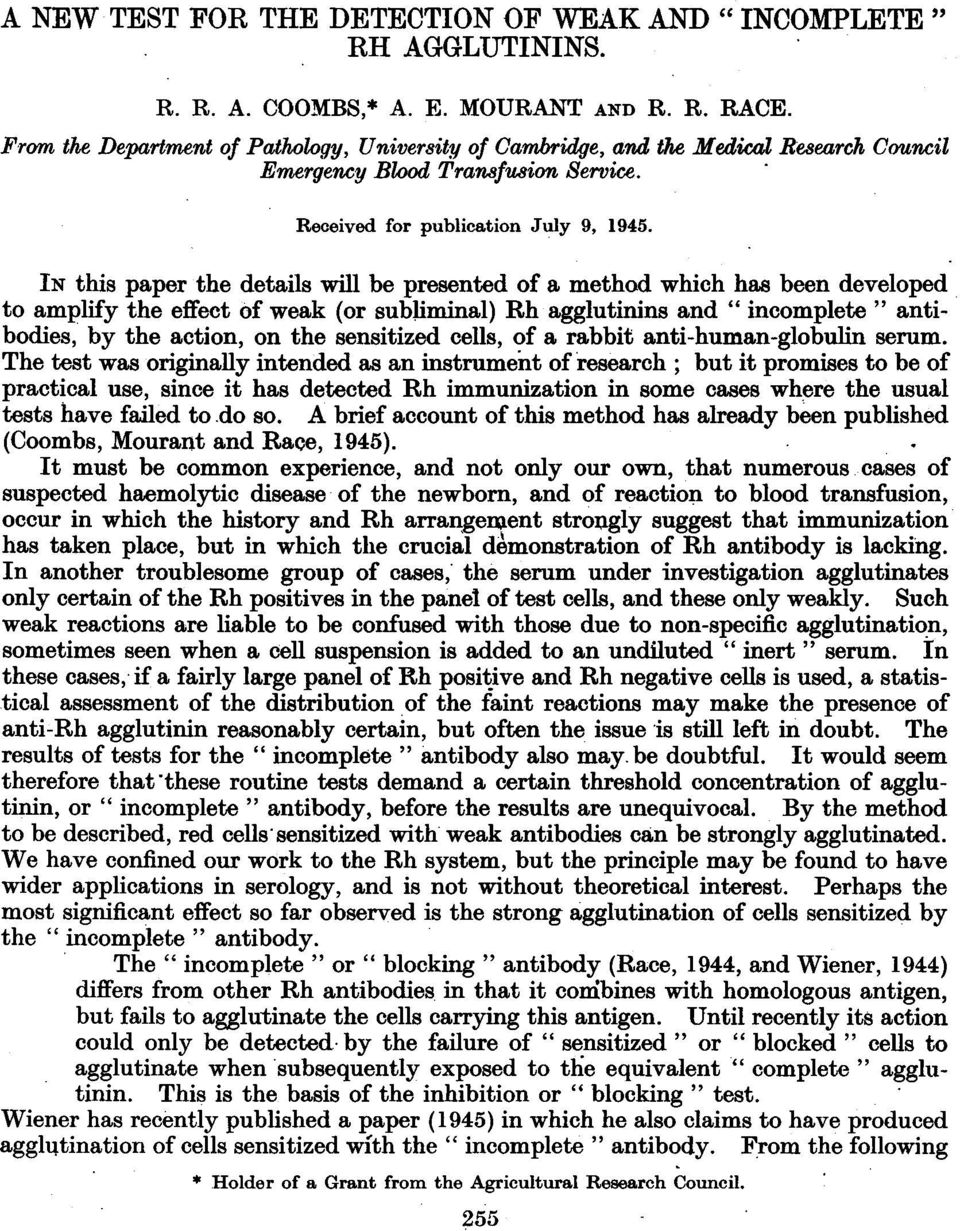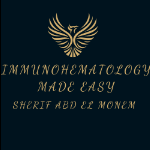Reputation Activity
-
 Arno got a reaction from Malcolm Needs in BloodBankTalk: Correct Blood Bank Nomenclature
Arno got a reaction from Malcolm Needs in BloodBankTalk: Correct Blood Bank Nomenclature
I just answered this question.
My Score PASS
-
 Arno got a reaction from Malcolm Needs in BloodBankTalk: Correct Blood Bank Nomenclature
Arno got a reaction from Malcolm Needs in BloodBankTalk: Correct Blood Bank Nomenclature
I just answered this question.
My Score PASS
-
 Arno reacted to Malcolm Needs in Dr Patricia Tippett.
Arno reacted to Malcolm Needs in Dr Patricia Tippett.
Well, the thing is John, when I first left school, I started to work as a VERY, VERY junior member of staff at the International Blood Group Reference Laboratory when it was in London. At that time Dr Kenneth Goldsmith was the Director, but others working there were Dr Carolyn Giles, Dr Elizabeth (Jan) Ikin, and a VERY young Joyce Poole. Across the carpark was the MRC Blood Group Unit, run by Drs Rob Race and Ruth Sanger, where Dr Patricia Tippett worked, along with Geoff Daniels, for a while Christine Lomas (before she went to the USA and became Christine Lomas-Francis) and, for a short time, Dr Marcela Contreras (before she became a Dame and a Professor). Just up the corridor was another set of laboratories run by Profs Walter Morgan and Winifred Watkins (and the janitor was one Sid Smith - after whom the SID Blood Group System was named).
As you can imagine, with all those "NAMES" working in such a small area of London, it was like a magnet for all of the other world's greats to come and visit (I even met Dr Arthur Mourant and Dr Philip Levine on visits).
With all these people, ALL of whom were amazingly helpful to even me, as someone who had just left school, what else could I do but fall deeply in love with the profession, and count my blessings from day one until I retired 43 years later. I have been one lucky man.
-
 Arno got a reaction from Malcolm Needs in BloodBankTalk: Clinical Aspects of Transfusion Reactions
Arno got a reaction from Malcolm Needs in BloodBankTalk: Clinical Aspects of Transfusion Reactions
I just answered this question.
My Score PASS
-
 Arno reacted to Sherif Abd El Monem in Clear as Glass Blood Banking - Sue Johnson.
Arno reacted to Sherif Abd El Monem in Clear as Glass Blood Banking - Sue Johnson.
And As you, Arno.....hahahaha
-
 Arno got a reaction from Sherif Abd El Monem in Clear as Glass Blood Banking - Sue Johnson.
Arno got a reaction from Sherif Abd El Monem in Clear as Glass Blood Banking - Sue Johnson.
There was no recording in these "good old days" unfortunately.
I had the chance to spend a few days with Sue some weeks ago (we were lecturing at the same event) and I should say that on the top of what Malcolm wrote which is very true, she is such a wonderful person, as Malcolm is!
-
 Arno got a reaction from Malcolm Needs in Clear as Glass Blood Banking - Sue Johnson.
Arno got a reaction from Malcolm Needs in Clear as Glass Blood Banking - Sue Johnson.
There was no recording in these "good old days" unfortunately.
I had the chance to spend a few days with Sue some weeks ago (we were lecturing at the same event) and I should say that on the top of what Malcolm wrote which is very true, she is such a wonderful person, as Malcolm is!
-
 Arno reacted to Malcolm Needs in Clear as Glass Blood Banking - Sue Johnson.
Arno reacted to Malcolm Needs in Clear as Glass Blood Banking - Sue Johnson.
I had the ENORMOUS honour of lecturing on a course with Sue in Cressier in Switzerland in 2015, and I can assure everyone that she is a consummate lecturer, who has the ability to get across the most difficult subjects, and make them fully understandable to even the most junior of staff.
-
 Arno reacted to Neil Blumberg in donor units with alloantibodies- policy for transfusion
Arno reacted to Neil Blumberg in donor units with alloantibodies- policy for transfusion
Our policy is to not transfuse to patients with the corresponding antigen (obviously ) and to wash the unit with Plasmalyte (our standard washing solution). I realize most places do not have the capability for washing or even centrifugation to remove most plasma. In that case, I would simply not use it for a patient. If you don't wash it, you then have to make sure the patient isn't transfused with an antigen positive unit later in their course, or at some other hospital. Too much opportunity for misadventure to my way of thinking.
-
 Arno reacted to Malcolm Needs in donor units with alloantibodies- policy for transfusion
Arno reacted to Malcolm Needs in donor units with alloantibodies- policy for transfusion
In the UK, such a unit would be offered to the National Frozen Blood Bank, and would only be frozen AFTER a thorough aseptic wash, followed by addition of a chemical to prevent the formation of sharp ice crystals, and then more washing upon thawing. There would be no allo-anti-Kpb left!
-
 Arno reacted to Malcolm Needs in Prenatal Antibody Titers
Arno reacted to Malcolm Needs in Prenatal Antibody Titers
Well, the first thing to say is that red cells CANNOT be either homozygous or heterozygous (or, come to that, hemizygous). These terms apply ONLY to genes, and red cells do not contain a nucleus. The antigens can only be described as, at best, "homozygous", "heterozygous" or "hemizygous" expression, or, alternatively, "double" or "single dose" expression.
Then, it HAS to be accepted that, unless the maternal antibody is an autoantibody, it must be an alloantibody (or, possibly, an isoantibody), which means that to mimic the state of the foetal red cells, the red cells used to titrate the antibody MUST have a "single dose" expression. However, that in itself presupposes that the foetal red cell antigens are all expressed at the same time, which we know is untrue (just look at the A, B and H antigens as an obvious example, but also the Kell antigens that are expressed much earlier than are the Rh antigens) or are ONLY expressed on foetal red cells, as opposed to other tissues (such as on the placental cells, which have, in some cases, been proved to adsorb the maternal antibodies).
Then, there is the fact that not all antibodies can be detected by all techniques. This is why Reference Laboratories SHOULD have more than one technology available (and their workers should be provably competent in these techniques. However, even then, not all techniques can predict the severity or otherwise of HDFN. For example, antibodies within the Indian Blood Group System always show that they can cause severe HDFN by certain techniques, such as MMA, but they don't! There is also the fact that the immunoglobulins may be IgM, IgA, IgG1, IgG2, IgG3 and IgG4 (to mention just a few), and I have yet to come across, or read about, an IgG4 immunoglobulin causing HDFN.
So, my answer is that there is a HUGE amount of knowledge known about the various antibody specificities, their titres, the expression of their cognate antigen, etc, etc, that there CANNOT be a single answer to your excellent question, but that the best thing that can be done is to read around the subject - and read around the subject from every source available - not just from a single country.
OKAY THEN, RIP ME APART!!!!!!!!!!!
-
 Arno got a reaction from Malcolm Needs in BloodBankTalk: Clinical Aspects of Transfusion Reactions
Arno got a reaction from Malcolm Needs in BloodBankTalk: Clinical Aspects of Transfusion Reactions
I just answered this question.
My Score PASS
-
 Arno reacted to Malcolm Needs in Deactivation of Insignificant Cold antibodies
Arno reacted to Malcolm Needs in Deactivation of Insignificant Cold antibodies
Another idea. Not mine, but I wish it was!
-
 Arno reacted to Malcolm Needs in Deactivation of Insignificant Cold antibodies
Arno reacted to Malcolm Needs in Deactivation of Insignificant Cold antibodies
Okay, so as long as the said antibody is tested each and every time, to ensure that the antibody specificity has not "broadened", but also that the thermal amplitude has not changed, so that, "this time" it may be a clinically significant "cold-reacting antibody", rather than a clinically insignificant "cold reacting antibody".
Sadly, it is not even THAT simple (if only), but it depends upon the specificity of the antibody and, to a certain extent, the ethnicity of the patient. "Cold-reacting" anti-M, for example, is known to be much more clinically significant in people from the Far East (particularly Japan) than in any other ethnic group, as far as I know.
However, if you take the "antibody" out of the computer system, so that it no longer flags, there is the very real possibility that a formally clinically insignificant "cold-reacting antibody", that has developed into a clinically significant "cold-reacting antibody" may be ignored - not "not detected" (far from it) but ignored, because "it was okay last time"!
All that having been said, I have NEVER understood why time and money is spent on determining the specificity of a genuine cold-reacting antibody, rather than just determining the thermal amplitude, to determine the clinical significance, and bothering to provide antigen negative blood, when there is zero chance of a haemolytic transfusion reaction!
-
 Arno got a reaction from SbbPerson in Wrong ABO typing by Gel
Arno got a reaction from SbbPerson in Wrong ABO typing by Gel
The most likely answer has been given above: newly formed autologous red cells have a lower gravity than transfused cells and will concentrate at the top of the re cell pellet whereas transfused cells will seat at the bottom. I hereby attach a paper describing that phenomenon. I hope Grifols will thank you for giving them the answer :-) 20230301142735376.pdf20230301142735376.pdf
-
 Arno got a reaction from Yanxia in Wrong ABO typing by Gel
Arno got a reaction from Yanxia in Wrong ABO typing by Gel
The most likely answer has been given above: newly formed autologous red cells have a lower gravity than transfused cells and will concentrate at the top of the re cell pellet whereas transfused cells will seat at the bottom. I hereby attach a paper describing that phenomenon. I hope Grifols will thank you for giving them the answer :-) 20230301142735376.pdf20230301142735376.pdf
-
 Arno got a reaction from Veejay in Wrong ABO typing by Gel
Arno got a reaction from Veejay in Wrong ABO typing by Gel
The most likely answer has been given above: newly formed autologous red cells have a lower gravity than transfused cells and will concentrate at the top of the re cell pellet whereas transfused cells will seat at the bottom. I hereby attach a paper describing that phenomenon. I hope Grifols will thank you for giving them the answer :-) 20230301142735376.pdf20230301142735376.pdf
-
 Arno got a reaction from AMcCord in Wrong ABO typing by Gel
Arno got a reaction from AMcCord in Wrong ABO typing by Gel
The most likely answer has been given above: newly formed autologous red cells have a lower gravity than transfused cells and will concentrate at the top of the re cell pellet whereas transfused cells will seat at the bottom. I hereby attach a paper describing that phenomenon. I hope Grifols will thank you for giving them the answer :-) 20230301142735376.pdf20230301142735376.pdf
-
 Arno reacted to RichU in Wrong ABO typing by Gel
Arno reacted to RichU in Wrong ABO typing by Gel
The same phenomenon is seen if you use a spun sample for DATs.
The cells at the top can be negative and the ones from the bottom positive if recently transfused.
-
 Arno reacted to Jsbneg in Wrong ABO typing by Gel
Arno reacted to Jsbneg in Wrong ABO typing by Gel
Thank you all so much for your explanations. I agree with jayinsat regarding the importance of transfusion history in this case, but I would have expected mixed field on the instrument, which was not the case. The concept of the density difference between the autologous RBCs vs the transfused RBCs and its impact on the probe sampling is very fascinating. Thank you all for sharing the papers that explain this phenomenon.
-
 Arno got a reaction from Jsbneg in Wrong ABO typing by Gel
Arno got a reaction from Jsbneg in Wrong ABO typing by Gel
The most likely answer has been given above: newly formed autologous red cells have a lower gravity than transfused cells and will concentrate at the top of the re cell pellet whereas transfused cells will seat at the bottom. I hereby attach a paper describing that phenomenon. I hope Grifols will thank you for giving them the answer :-) 20230301142735376.pdf20230301142735376.pdf
-
 Arno reacted to Malcolm Needs in Wrong ABO typing by Gel
Arno reacted to Malcolm Needs in Wrong ABO typing by Gel
Thanks for this explanation Arno. I should have thought of it myself (but didn't!) as my friend Bill Chaffe, a former President of the BBTS described just such a situation in a meeting a few years back.
-
 Arno got a reaction from Malcolm Needs in Wrong ABO typing by Gel
Arno got a reaction from Malcolm Needs in Wrong ABO typing by Gel
The most likely answer has been given above: newly formed autologous red cells have a lower gravity than transfused cells and will concentrate at the top of the re cell pellet whereas transfused cells will seat at the bottom. I hereby attach a paper describing that phenomenon. I hope Grifols will thank you for giving them the answer :-) 20230301142735376.pdf20230301142735376.pdf
-
 Arno reacted to Malcolm Needs in Confirm anti-D (vs anti-G) via titers?
Arno reacted to Malcolm Needs in Confirm anti-D (vs anti-G) via titers?
It is usual for the C+, D- red cells (e.g. r'r) to react with an anti-G more strongly than a C-, D+ red cell (e.g. R2R2), BUT, this is by no means "diagnostic".
As Jsbneg says above, it would be far safer to perform the proper tests, to ensure you have ascertained the correct specificity/specificities.
The attached PowerPoint may or may not help (ignore if it is not helpful).
The G Antigen and Anti G.pptx
-
 Arno reacted to Malcolm Needs in Complement activating cold antibody
Arno reacted to Malcolm Needs in Complement activating cold antibody
I have an idea of what I think it might be, but I would hesitate to say without a bit more information concerning the condition and underlying pathology of the patient.
How old is the patient? Have they recently had something like an atypical pneumonia?
I think, without knowing the answer to the above questions, that the specificity of the antibody MAY be between "anti-O" and "anti-Q".
I would suggest performing an indirect DL-test.
I may well be wrong, OF COURSE, but the attached may help.
Paroxysmal Cold Haemoglobinuria (PCH).pptx





